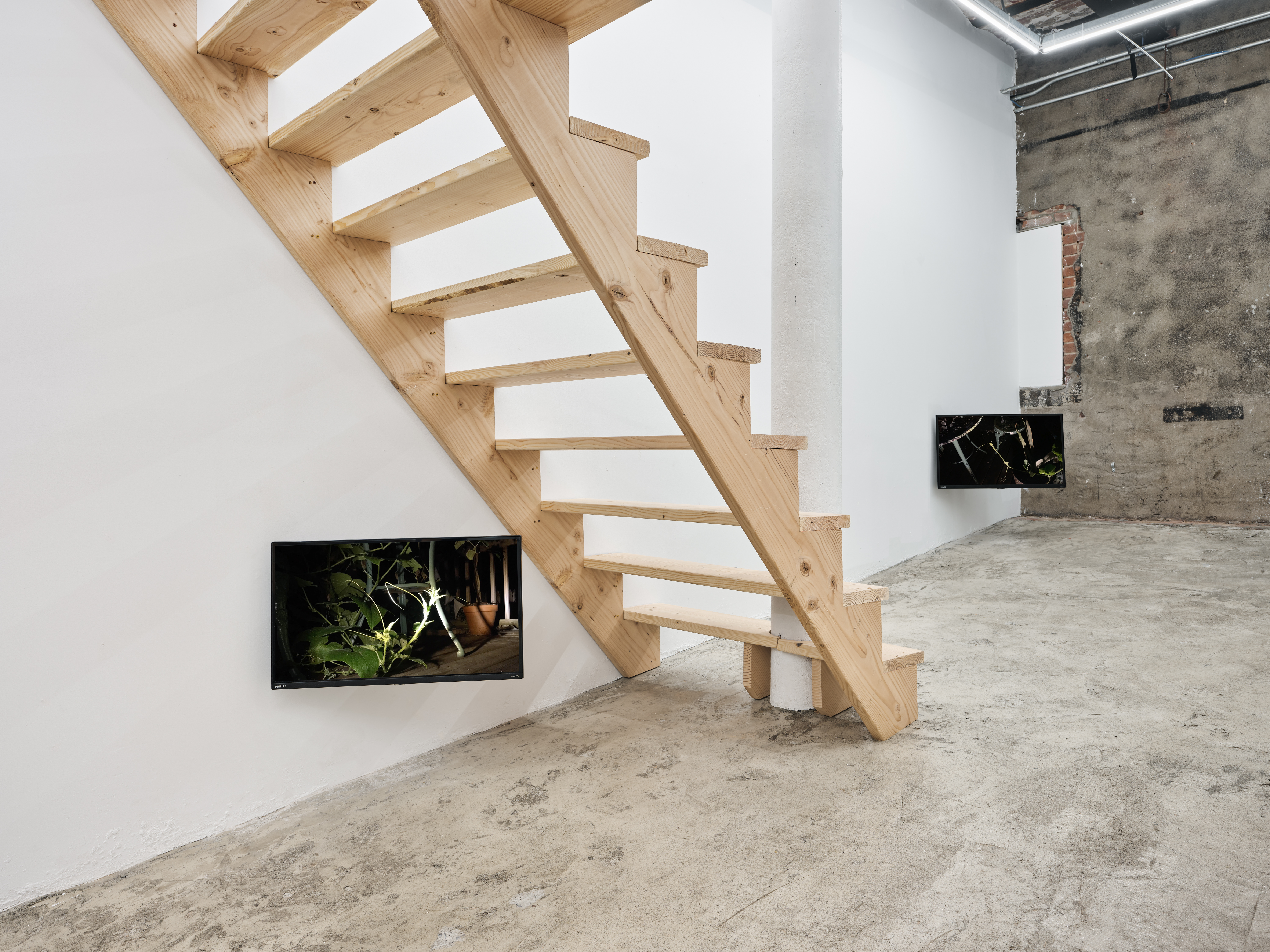chevron
4.27.2024 - 6.30.2024











“What troubles the mind is that sight should tolerate the fact that big and small are not, necessarily, distinct, separate terms, that the one may become the other… Thus the eye is disturbed by the contradictions set before it will gradually learn to train its gaze upon ideas. Fixed ideas. But for ideal measurement and ideal value, reference will have to be made to the standard…[Standard] size outstrips anything nature can envisage. It is not that it refuses to materialize but that its activity knows no intrinsic limits. In the first place, it has no need or desire to be made manifest and come into existence. Its being and perfection are self-sufficient. No receptacle can satisfy it or is capable of holding it entirely. ‘That which we term heaven or the universe … partakes of a bodily nature, and therefore cannot be entirely free of perturbation.’”1
Luce Irigaray, Speculum of the Other Woman, 1975
Twin stairways ascend from the floor to the ceiling. Spanning the width of the space, the trajectory of the stairs is countered by a floor which rises in the opposite direction. The stairs and the inclining floor meet in a V; the descension of one is met by the ascension of the other. For the exhibition chevron at International Waters, Emily Janowick articulates space with staircases that form a common icon.
Entering from beneath the stairs, Janowick’s architectonic chevrons are first met from below. The steps, without risers, divide the space into columns of horizontal slits. Rising along a predetermined pathway within the body of the stairs, each passage relates its shape to the story exits of an arena vomitorium. Beneath each staircase, a sequence of monitors cast time-lapse videos of animated vines climbing and penetrating the decking of the artist’s backyard in Ridgewood, Queens. The steps, connected to the monitors with cable, are tuned as speakers to broadcast a sound piece that the artist recorded with her daughter, Shiloh Blue.
In such a context, the conditions of a communicating environment are emphasized. The guided experience of any landscape is permeated by language. When architecture takes the form of a symbol, the distinction between inside and outside is transgressed. “Because the spatial relationships are made by symbols more than by forms, architecture in this landscape becomes a symbol in space rather than form in space.”2 Dominating the natural landscape with a semantic order, architecture creates false unities and divisions with its surroundings.
Familiar forms like the staircase take on diverse meaning and narrative. The ascension of a flight of stairs can suggest a stairway to heaven; vines that creep through the cracks of a step can relate their movements to an uprising over geometric oppression. Janowick, producing videos from her backyard steps with an iPhone and Makita flashlight, connects her practice directly to her surroundings and to her daughters who recently moved away:
“During the last 40 nights that my eldest daughter lived at home before she went to college, I recorded the gourd vines in our backyard growing in the darkness while she slept. Two years later, as my younger daughter prepared to move out, we grew the gourds again, repeating the ritual. I usually have made my work at night, whenever the kids were asleep. Recording these videos was the last moments of knowing when everyone went to bed.”3
For Janowick, the dance of a growing vine relates its movements to her daughters; the vine grows at a speed that defies observation. In her ritual-practice, Janowick as mother and artist, aligns herself with her home. A mother contains her daughters much like the home contains its inhabitants. The organization of the home transposes itself onto the family. The stairway is an architectural depiction of organized growth. Descending the steps into her backyard, Janowick finds synthesis with a vine that rises in the opposite direction. The descension of one is met by the ascension of the other.

1. Irigiray, Luce; Speculum of the Other Woman, translated by Gillian C. Gill (Ithaca: Cornell University Press, 1985). Excerpt from “A Form That Is Always the Same” (p. 304) with a quotation from Plato’s “Statesman (dialogue)”.
2. Venturi, Robert, Denise Scott Brown, and Steven Izenour. Learning from Las Vegas: The Forgotten Symbolism of Architectural Form. (Cambridge: MIT Press, 1977).
3. In conversation with the artist.
